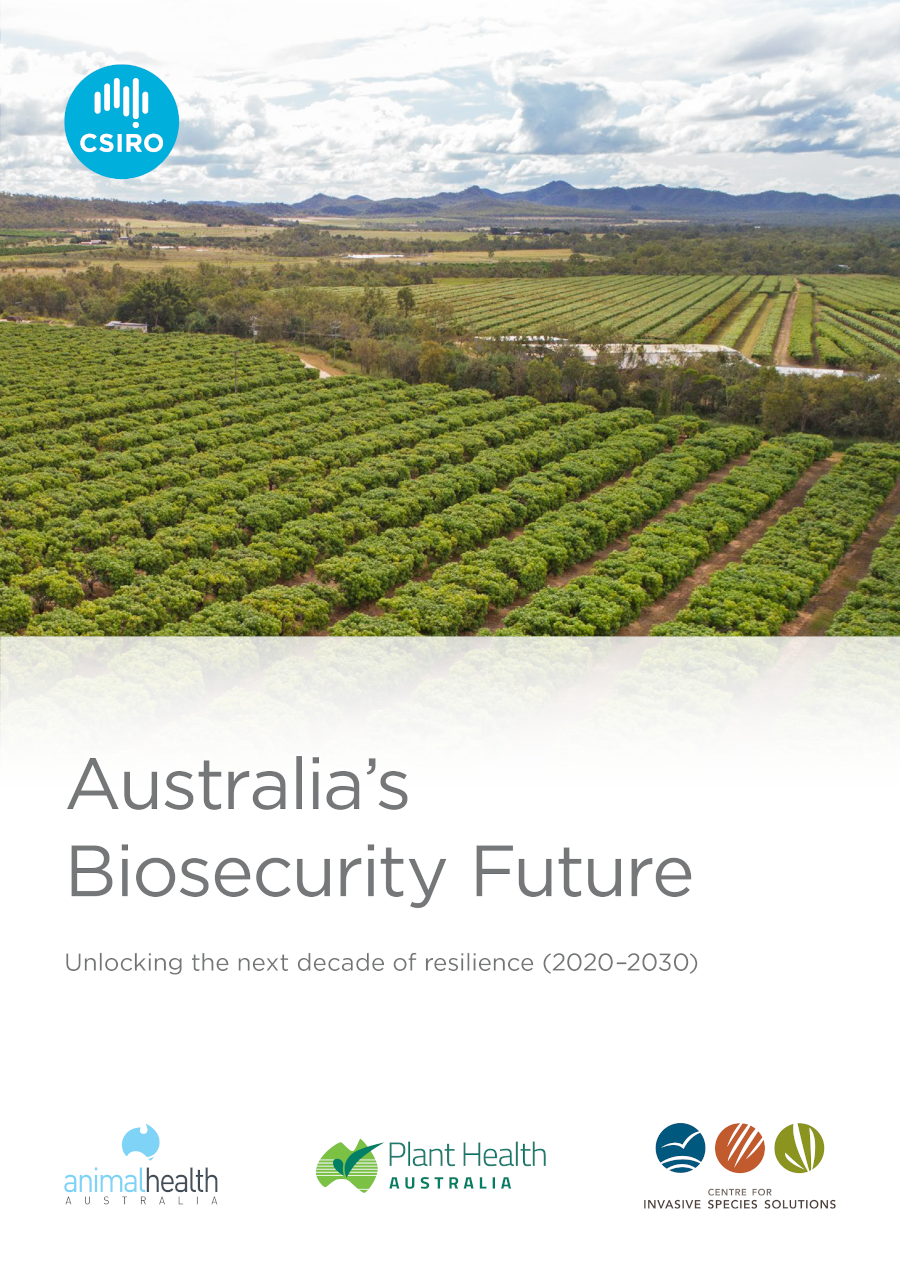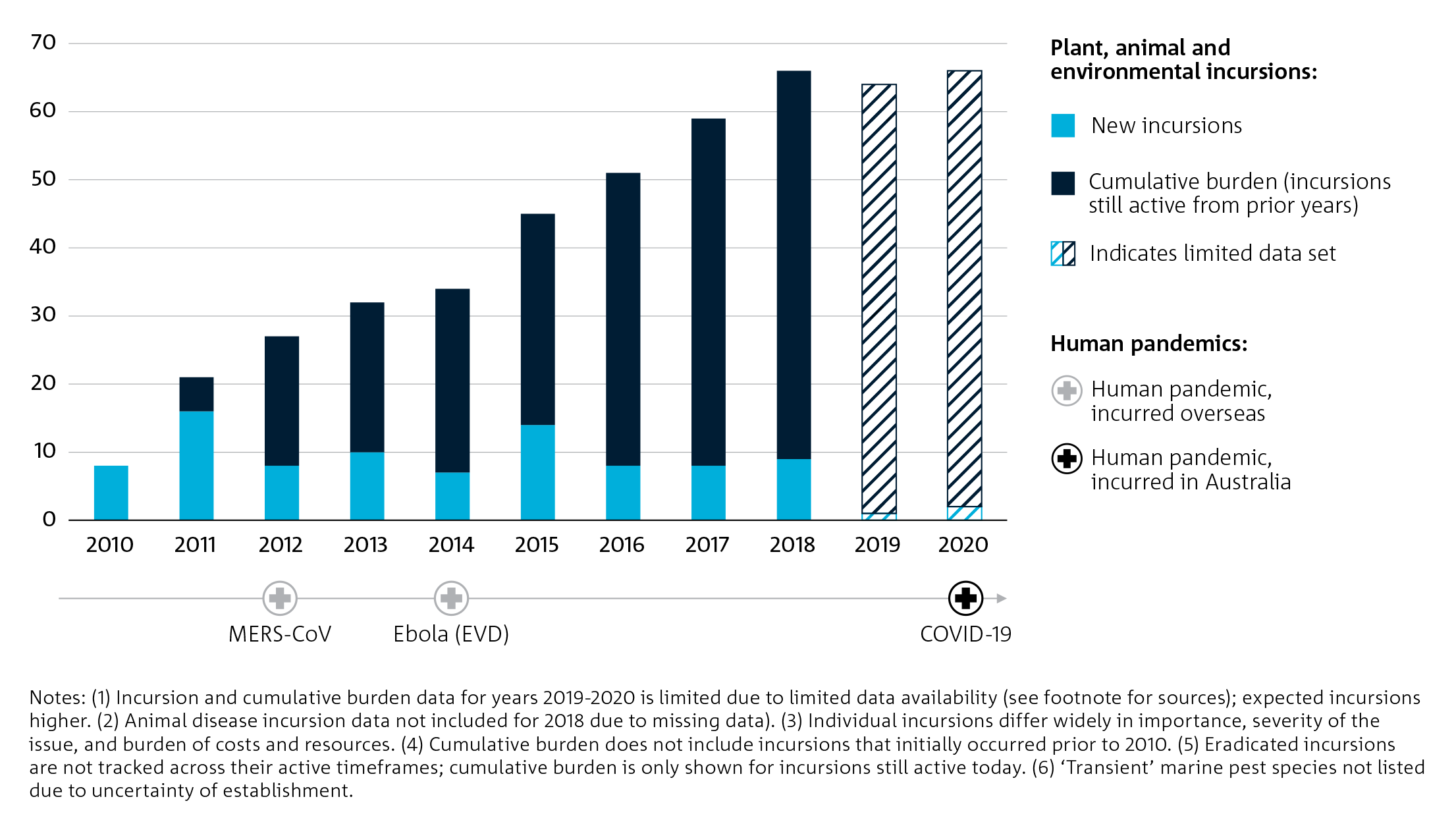Looking to the future of Australia's biosecurity system
 In partnership with Animal Health Australia, Plant Health Australia, and the Centre for Invasive Species Solutions, CSIRO has consulted widely to develop an action-oriented update to its 2014 report 'Australia's Biosecurity Future: Preparing for future biological challenges'.
In partnership with Animal Health Australia, Plant Health Australia, and the Centre for Invasive Species Solutions, CSIRO has consulted widely to develop an action-oriented update to its 2014 report 'Australia's Biosecurity Future: Preparing for future biological challenges'.
The report was developed collaboratively through interviews and workshops with 26 organisations across the biosecurity system; including Commonwealth and state governments, research, industry and non-government organisations.
Download the report
Read our insights on a vision for a biosecurity system transformation by 2030.
Australia's Biosecurity System
Biosecurity is critical to supporting the health and wellbeing of Australian people, resilient communities, healthy ecosystems, and sustainable food systems. While Australia has one of the strongest biosecurity systems globally, outbreaks across human, agriculture, environment and marine health are continuing to rise in volume and complexity.
Between 2012 and 2017, the annual number of interceptions of biosecurity risk materials at Australian borders rose by almost 50 per cent, to 37,014.

Scaling current approaches will not be enough; transformational change is needed
The costly ongoing management of established species coupled with the increasing risk of new incursions is placing growing strain on the system which is already experiencing resourcing challenges. While investments are being made towards some of these challenges, continuing along the 'business as usual' (BAU) trajectory of slow and incremental change could expose Australia to significant triple bottom line risks over the next 10 years.
Modelling shows that even almost tripling investment in interventions out to 2025 will still result in increased residual biosecurity risk compared to 2014-2015 levels. The system requires more transformational change in approaches and responsibilities to generate greater efficiencies and effectiveness.
Now is the time for a system re-think
Preparing Australia for biosecurity resilience in 2030 will require setting nationally coordinated goals across the One Health spectrum (human, agricultural, environmental and marine health sectors). Pursuing the transformational trajectory will require stronger collaboration across governments, industry, research and the community.
This report provides recommendations under three key themes:
- System connectivity – digitisation and enhancing data sharing across supply chains and the human, agricultural, environmental and marine health sectors to ensure we identify and manage emerging risks.
- Shared responsibility – enabling the role of industry and community in biosecurity responsibility through improved community engagement; more systemic collaborations between Indigenous and non-Indigenous organisations and individuals; and working with industry to develop their role in surveillance.
- Science and technology – supporting the growth of novel tech-enabled start-ups that create business opportunities for biosecurity, as well as developing international biosecurity innovation priorities for the sector to focus and collaborate on.
Looking to the future of Australia's biosecurity system
In partnership with Animal Health Australia, Plant Health Australia, and the Centre for Invasive Species Solutions, CSIRO has consulted widely to develop an action-oriented update to its 2014 report 'Australia's Biosecurity Future: Preparing for future biological challenges'.
The report was developed collaboratively through interviews and workshops with 26 organisations across the biosecurity system; including Commonwealth and state governments, research, industry and non-government organisations.
Download the report
Read our insights on a vision for a biosecurity system transformation by 2030.
Australia's Biosecurity System
Biosecurity is critical to supporting the health and wellbeing of Australian people, resilient communities, healthy ecosystems, and sustainable food systems. While Australia has one of the strongest biosecurity systems globally, outbreaks across human, agriculture, environment and marine health are continuing to rise in volume and complexity.
Between 2012 and 2017, the annual number of interceptions of biosecurity risk materials at Australian borders rose by almost 50 per cent, to 37,014.
Scaling current approaches will not be enough; transformational change is needed
The costly ongoing management of established species coupled with the increasing risk of new incursions is placing growing strain on the system which is already experiencing resourcing challenges. While investments are being made towards some of these challenges, continuing along the 'business as usual' (BAU) trajectory of slow and incremental change could expose Australia to significant triple bottom line risks over the next 10 years.
Modelling shows that even almost tripling investment in interventions out to 2025 will still result in increased residual biosecurity risk compared to 2014-2015 levels. The system requires more transformational change in approaches and responsibilities to generate greater efficiencies and effectiveness.
Now is the time for a system re-think
Preparing Australia for biosecurity resilience in 2030 will require setting nationally coordinated goals across the One Health spectrum (human, agricultural, environmental and marine health sectors). Pursuing the transformational trajectory will require stronger collaboration across governments, industry, research and the community.
This report provides recommendations under three key themes:
- System connectivity – digitisation and enhancing data sharing across supply chains and the human, agricultural, environmental and marine health sectors to ensure we identify and manage emerging risks.
- Shared responsibility – enabling the role of industry and community in biosecurity responsibility through improved community engagement; more systemic collaborations between Indigenous and non-Indigenous organisations and individuals; and working with industry to develop their role in surveillance.
- Science and technology – supporting the growth of novel tech-enabled start-ups that create business opportunities for biosecurity, as well as developing international biosecurity innovation priorities for the sector to focus and collaborate on.
